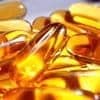Vitamin D is an essential vitamin required by the body for the proper
absorption of calcium, bone development,
control of cell growth, neuromuscular functioning, proper immune
functioning, and alleviation of inflammation.
A deficiency in vitamin D can lead to rickets, a disease in which bones
fail to properly develop. Further, inadequate levels of
vitamin D can lead to a weakened immune system, increased cancer risk,
poor hair growth, and osteomalacia, a condition of weakened muscles
and bones. Conversely, excess vitamin D can cause the body to absorb too
much calcium, leading to increased risk of heart attack and
kidney stones. The current U.S.
DV for vitamin D is 600 IU
(international units) and
the toxicity threshold for vitamin D is thought to be 10,000 to 40,000
IU/day.
2
Vitamin D is oil soluble, which means you need to eat fat to absorb it.
It is naturally found mainly in fish oils, fatty
fish, and to a lesser extent in beef liver, cheese, egg yolks, and
certain mushrooms. Vitamin D is also naturally made by
your body when you expose your skin to the sun, and thus, is called the
sun-shine vitamin. In addition, vitamin D is widely added
to many foods such as milk and orange juice, and can also simply be
consumed as a
supplement.
Below is a list of high vitamin D foods.
 #1: Cod Liver Oil
#1: Cod Liver Oil
Cod liver oil has been a popular supplement for many years and naturally contains very high levels
of
vitamin A and vitamin D. Cod liver oil provides 10001IU (1667% DV) per 100 gram serving, or
1360IU (340% DV) in a single tablespoon.
 #2: Fish
#2: Fish
Various types of fish are high in vitamin D. Typically raw fish contains
more vitamin D than cooked, and fatty cuts
will contain more than lean cuts. Further, fish canned in oil will have
more vitamin D than those canned in water. Raw fish
is typically eaten in the form of sushi. Raw Atlantic Herring provides
the most vitamin D with 1628IU (1667% DV) per 100 gram serving, 2996IU
(499% DV) per fillet,
and 456IU (76% DV) per ounce. It is followed by Pickled Herring with
680IU (113% DV) per 100g serving, Canned Salmon (127% DV),
Raw Mackerel (60% DV), Oil Packed Sardines (45% DV), Canned Mackerel
(42% DV), and oil packed Tuna (39% DV).
 #3: Fortified Cereals
#3: Fortified Cereals
A breakfast staple in the Americas, most commercial cereals are fortified with the essential vitamins and nutrients.
Exercise caution and check food labels when purchasing cereals, be sure to pick products that have little or no refined
sugars, and no partially hydrogenated oils! Fortified cereals can provide up to 342IU (57% DV) per 100 gram serving (~2 cups),
and even more if combined with fortified dairy products or fortified soy milk. Products vary widely so be sure to check
the nutrition label before buying.
#4: Oysters
In addition to vitamin D, Oysters are a great source of
vitamin b12,
zinc,
iron,
manganese,
selenium,
and
copper. Oysters are also
high in
cholesterol and
should be eaten in moderation by people at risk of heart disease or stroke.
Raw wild caught Eastern Oysters provide 320IU (80% DV) per 100 gram serving, 269IU (67% DV) in six medium oysters.
#5: Caviar (Black and Red)

Caviar is a common ingredient in sushi and more
affordable
than people think.
Caviar provides 232IU (58% DV) of vitamin D per 100 gram serving, or 37.1IU (9% DV) per teaspoon.
 #6: Fortified
#6: Fortified
Soy Products (Tofu and Soy Milk)
Fortified soy products are often fortified with both vitamin D and
calcium.
Fortified Tofu can provide up to 157IU (39% DV) of vitamin D per 100 gram serving, or 44IU (11% DV) per ounce.
Fortified Soy Milk can provide up to 49IU (12% DV) of vitamin D per 100 gram serving, 119IU (30% DV) per cup.
Amounts of vitamin D vary widely between products, so be sure to check nutrition facts for vitamin D content.
 #7: Salami, Ham, and Sausages
#7: Salami, Ham, and Sausages
Salami, Ham, and Sausages are a good
source of
vitamin b12,
and
copper. Unfortunately, they are also
high in
cholesterol and
sodium, and so should be limited by people at risk of
hypertension, heart attack, and stroke. Salami provides 62.0IU (16% DV) of vitamin D per 100 gram serving, or
16.7IU (4% DV) per ounce (3 slices). It is followed by Bologna Pork 56IU (9% DV) per 100 grams,
and Bratwurst 44IU (7% DV) per 100 gram serving.
 #8: Fortified Dairy Products
#8: Fortified Dairy Products
Dairy products are already high in
calcium,
so it makes sense to fortify them with vitamin D. Milk can provide up to
52.0IU
(13% DV) of vitamin D per 100 gram serving, 127IU (32% DV) per cup.
Cheese can provide up to
6.6IU (2% DV) in a cubic inch, and butter provides 7.8IU (2% DV) in a
single tablespoon. Check nutrition labels for exact amounts.
 #9: Eggs
#9: Eggs
In addition to vitamin D, eggs are a good source of
vitamin B12,
and
protein.
Eggs provide 37.0IU (9% DV) of vitamin D per 100 gram serving, or 17.0IU (4% DV) in a large fried egg.
 #10: Mushrooms
#10: Mushrooms
More than just a high vitamin D food, mushrooms also provide
Vitamin B5 (Pantothenic Acid)
and
copper.
Lightly cooked white button mushrooms provide the most vitamin D with 27.0IU (7% DV) per 100 gram serving,
or 7.6IU (2% DV) per ounce.
 Dysphoric features are statistically salient in patients with mania,
and the bimodal distribution of the dysphoria factor is consistent with
the possibility that mixed bipolar disorder is a distinct state.
Dysphoric features are statistically salient in patients with mania,
and the bimodal distribution of the dysphoria factor is consistent with
the possibility that mixed bipolar disorder is a distinct state. 












